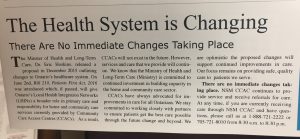DLSPH Blog – Community-driven health system innovation
July 20/2017
The DLSPH Blog is a digital platform that will explore issues that impact public health and health systems scholars on a biweekly basis written by Interim Dean Adalsteinn Brown in collaboration with DLSPH faculty, staff and students.
For blog ideas, feedback or comments, contact: communications.dlsph@utoronto.ca
It’s hard to separate your health (or health care) from where you live. For decades, scholars have shown that your likelihood of getting a particular medical procedure or even of dying prematurely depends heavily on where you live. Dubbed the postal code lottery, this finding has dominated thinking about health and health care, but relatively little has percolated into how we actually plan our health systems to meet our local health care and population health needs.
In some ways, this is not surprising. Policy is nothing more than a consistent way to make important decisions. When governments develop policies, a key aim is for these policies to be applied uniformly, so that they are seen as fair and legitimate. Both ministers and senior public servants rest easier when they know that requests for funding or for new programs or services are processed according to a policy that is consistently applied to all applicants.
However, communities get frustrated when policies are applied in ways that fail to acknowledge the differences that geography, history, or other factors bring to the table. A policy that provides funding for relief of physicians does little to help a community that does not have a physician and a policy that prevents the transfer of money across sectors does little to help a community where these sectors are ready to work together and where trust and relationships have already been established.
Ontario has recently passed legislation — the Patients First Act — that enables a range of new interactions among sectors. But it does not tell individual providers how they are supposed to change what they do on a day-to-day basis, or even how communities are supposed to design their health system. This means that communities face an important choice when considering the future of their health system: they can wait for policy-makers to fill the inevitable vacuum as providers contemplate how to respond to this new legislation or they can chart their own course towards the health-care system that works for their community.
Over the past two years, my colleagues and I have had the privilege to work with two communities that have seized this opportunity. The first is in Muskoka and Area. There, as part of the Muskoka and Area Health System Transformation (MAHST) project, representatives of municipalities, health-care providers, social services, public health, and the public are working together to chart a course for a new health-care system, one that is capable of reaping the benefits of integration by bringing as many health-care providers together as possible.
Perhaps as importantly, this community has learned the lessons of Health Links and has made sure that social care providers — largely our municipalities — are at the table and a committed partner from the start. MAHST represents a new and important purposeful approach to planning health-care systems at the community level, an approach that can be enabled but not controlled at the policy level.
The second is in Barrie. In the Healthy Barrie Project, the city, family physicians, and the public health unit have come together to work on activities that are aligned to support innovation and health improvement. This model provides a platform for strengthening the entire health-care system’s ability to promote healthy behaviours and advocate for healthier communities because programs and projects are approved together.
The first such project builds off of a successful model from Washington, D.C., where physicians encourage patients to spend more active time outdoors. With this model, municipal resources — of which a city like Barrie should be proud — can contribute even more to health; public health units gain a broader set of partners with whom to plan, advocate and deliver; and family physicians gain greater opportunities for promoting health.
I saw a newspaper article a few months ago that announced “The Health System is Changing. There Are No Immediate Changes Taking Place.” The risk of major policy announcements is that expectations are built while broad action remains hard to realize. It is too easy to say that we need to wait for direction. The actions of Muskoka and Area and Barrie show that communities can and should take advantage of the opportunities offered by new policies without waiting for top-down direction.
Our obligation as scholars is to work with these communities to achieve better health, ensuring that the evidence and insights generated at places like DLSPH are resources available to all.
– Professor Adalsteinn Brown, Interim Dean, Dalla Lana School of Public Health & Dalla Lana Chair of Public Health Policy, in collaboration with: Professor Ross Upshur, Clinical Public Health Division Head; Aamir Bharmal, a final-year Public Health and Preventive Medicine resident working on the Healthy Barrie project; and Patrick Feng, Healthy Barrie project manager.


